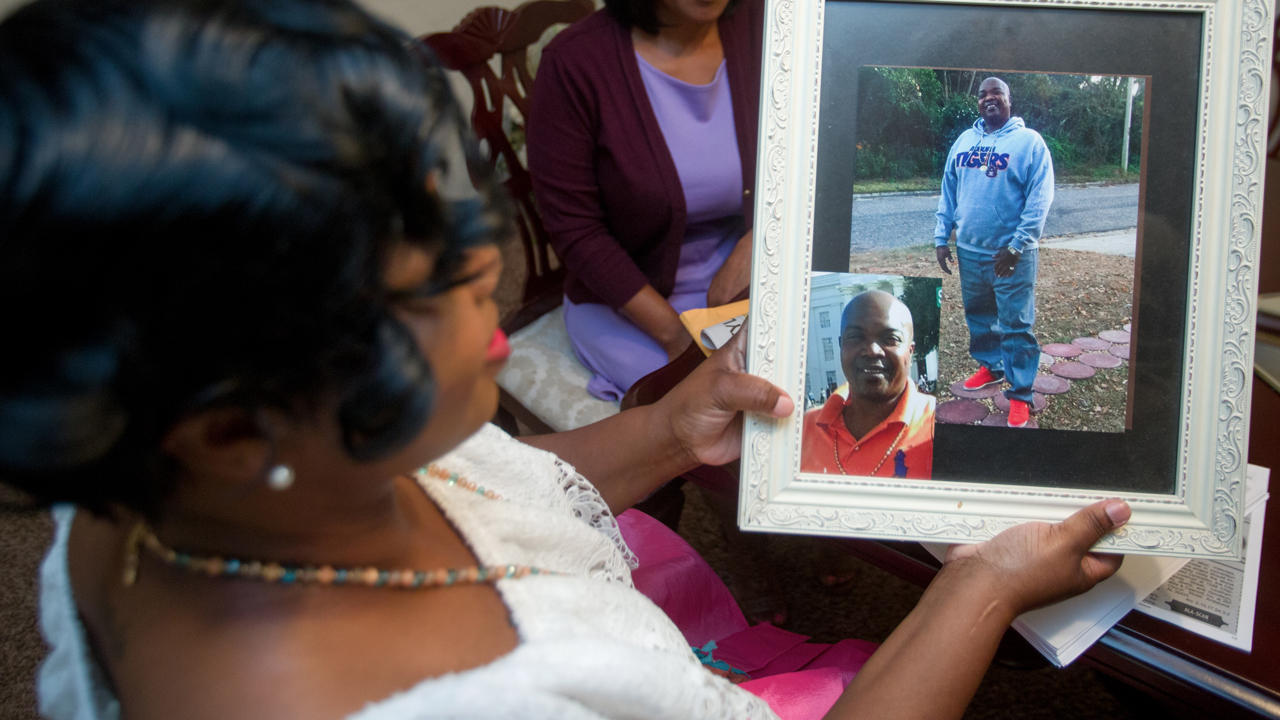An Alabama man died. Then cash-strapped prosecutors fought his family for his house
Wayne Bonam jumped up, blinded by a flash-bang grenade, as police swarmed through the door and pointed guns at his head. His girlfriend, next to him, shouted at the cops: “Hey, wait – he has a bad heart!”
Wayne, 41, was indeed ill. More than a decade of heart problems left him with a fragile cardiovascular system, and the smoke from the grenade thrown into his home by police did not help. He would never recover after the September 2015 raid, which was carried out by 22nd Judicial Circuit Drug Task Force agents in the small South Alabama town of Andalusia. Coughing up blood, Wayne Bonam was hospitalized weeks later. He died the following November.
Wayne’s death was already a tragedy. But, for his family, it was only compounded by what police and prosecutors did next.
The night of the raid, agents said they found cocaine and $18,282 in cash inside Wayne’s house. Prosecutors never proved the allegations in criminal court. District Attorney Walt M. Merrell III and his team dropped the charges after Wayne died.
But that didn’t end the case. The police wanted his house.
And they got it through a procedure called civil asset forfeiture – a legal process that has been widely condemned by critics on the right and the left as an assault on the due process and property rights of Americans and, essentially, a perversion of law enforcement rooted in the failed policies of America’s drug war.
> Read our policy brief on civil asset forfeiture.
To take Wayne’s house for their own, the prosecutors never needed a court or jury to find him guilty of a crime. They didn’t need him to be alive, for that matter. In Alabama, as in many states, no criminal conviction is necessary for police to seize, and keep, others’ property. Nor are criminal charges. Civil asset forfeiture turns the American concept of “innocent until proven guilty” on its head. Rather than prove a person guilty “beyond a reasonable doubt,” prosecutors need only prove the property was probably connected to a crime.
The prosecutors ultimately won their civil case against Bonam’s house. This past August, the house fetched $76,000 at auction. Together with Wayne’s cash, the seized property was worth $94,282. On Oct. 12, everyone who had a hand in the forfeiture got a cut. The cash-strapped drug task force received $74,612. The prosecutor’s office walked away with $18,653. Even the court overseeing the proceedings collected $1,017.
Meanwhile, Wayne’s family – including his 12-year-old son, his sisters Marion and Michelle, and his parents, Marilyn and Albert – was left with bitterness and grief.
“We fought it all the way until we couldn’t fight it anymore,” Michelle Bonam said. “My mom used the insurance money that we got for his burial to fight to get his property.”
The SPLC recently interviewed family members at Marilyn Bonam’s home in Montgomery, the state capital. Marion and Michelle described their brother as a humble person who was good with his hands. He was a mechanic who at any given time had several cars around his house that served as his projects. “Even while he was sick he was humble,” Michelle Bonam said. “You know how some people get ill and they get kind of frustrated? He was still sweet.”
> Read more on how 'highway robbery' allows police to seize cash, property.
Marilyn sobbed as she told the SPLC how she sees her son’s death, the drug raid and the forfeiture as part of one long, painful episode. “They could have knocked on the door, and he would’ve let them in, it wouldn’t have been a problem,” she said. “When they threw that bomb in there, it killed his heart. … If they’d just given me my baby, they could’ve had the house.”
Whenever news about the ordeal popped up online or in the Andalusia newspaper, Marilyn said, “it was just like taking a knife, sticking it in my heart and twisting it.”
While wiping away her own tears during the interview, Michelle comforted her mother, who had begun to sob. “To me, it’s not fair,” Michelle said. “If he had gone to court, and you found him completely guilty, and you had your evidence, you had these witnesses, you had video tape … then there’s nothing I could do. But to me, you took [the house], and you had nothing.”
A perfect target
The fundamental unfairness of civil forfeiture laws has created a strange bedfellows coalition of advocates in recent years. In Alabama, for example, the SPLC is working alongside groups like the conservative Institute for Justice and the Charles Koch Institute to seek legislative reforms. The SPLC believes the state must protect the rights of innocent property owners and bring transparency to the process.
There is widespread agreement that civil asset forfeiture laws, which originated in the 1970s as part of the drug war, do little to prevent illegal activity and have, in effect, become money-making operations for law enforcement agencies. The potential for abuse is built into the system. In most states, agencies are entitled to keep the property they seize, even if the owner is never charged with a crime. These agencies can largely use the money however they want, without any oversight, and many states do not even require them to track or report it.
In Wayne Bonam’s case, no argument can be made that the forfeiture of his house disrupted any criminal activity whatsoever. He had already died. Broadly, forfeitures do not lead police to solve more crimes, a pair of economists concluded in a 2016 paper published by the academic journal Economic Inquiry. At the federal level, the Department of Justice (DOJ) inspector general reported this past March that in 56 of 100 Drug Enforcement Agency forfeiture cases examined by the office, “there was no discernible connection between the seizure and the advancement of law enforcement efforts.”
But there is a powerful constituency against reform: law enforcement.
Alabama is one of the states where law enforcement agencies can receive all of the proceeds from the sale of seized property, simply adding it to their budgets to use as they see fit.
What’s more, the federal government today encourages the practice through drug war programs and grant money.
Sometimes, particularly in states that restrict the use of forfeited funds, local or state police will allow the DOJ to “adopt” the forfeiture through a program called Equitable Sharing. Former Attorney General Eric Holder limited the program in 2015, but Attorney General Jeff Sessions recently reversed Holder’s reforms and announced a more expansive program. Local police will likely rush to participate again. Equitable Sharing is easy for them to use, and at the end of a federal proceeding, local agencies can receive up to 80 percent of the proceeds awarded through a federal forfeiture, with federal authorities keeping the other 20 percent. Everyone wins – except the property owner, who might not even be charged with a crime.
The federal government has also footed the bill for countless local anti-drug initiatives in which civil asset forfeiture is a common tactic. The money flows from the DOJ through a program known as Byrne Justice Assistance Grants. In Alabama, the DOJ annually pours more than $3 million in Byrne funds into the Alabama Department of Economic and Community Affairs (ADECA), which distributes the money to local authorities. The funds come with an order to “establish and or support multi-jurisdictional drug and violent crime task forces throughout the state, with the intent of reducing illegal drug activity through increased arrests and prosecution of prime offenders.” The 22nd Judicial Circuit Drug Task Force in Covington County, which made off with the lion’s share of the proceeds from Wayne’s house, is one such creation.
In fact, the funds from Wayne Bonam’s house may help the Covington County task force, founded in 2000, make up for sharply falling federal funding.
Made up of five agents from the Andalusia Police Department, the Covington County Sheriff’s Department and the nearby Opp Police Department, the task force has repeatedly taken advantage of federal policies and grants since at least 2008. (It enrolled in Equitable Sharing in at least 2012 and 2013, according to documents obtained by The Washington Post, though the records for those years show no forfeitures adopted by federal agencies.) The Covington County Commission, which dispenses money to the task force, received more than $900,000 in DOJ grants through ADECA between 2008 and 2017.
By 2013, though, the county commission’s Byrne funding was already falling from year to year. The drug task force, in turn, saw less and less financial support. ADECA’s grants to the county, which at their highest totaled $273,366 in fiscal year 2008, dropped to $56,601 in fiscal year 2015 and have continued to decline since then. Regardless, county officials were reluctant to shutter the task force or fold it into the drug agency in the nearby city of Dothan.
Asset forfeitures helped to plug the funding holes.
In 2011, when the county commission received $132,172 in DOJ grant money through ADECA, prosecutors filed zero asset forfeiture cases, according to court records. In 2013, after the size of the grant from ADECA fell to $81,710 – from $115,949 the previous year – prosecutors brought 13 forfeiture cases based on task force operations. A judge awarded most of the proceeds to prosecutors and the task force itself. The drug agents cracked down on people buying and selling marijuana, seizing more than $19,000 in cash, three vehicles and five guns. In a prelude to Wayne Bonam’s case, they also took one parcel of land.
By 2015, the result in Covington County was a Frankenstein’s monster of a task force, cobbled together with resources from different agencies, addicted to drug money and in need of more.
Wayne’s house was a perfect target.
"Separate and apart"
Civil asset forfeiture was invented, in essence, as a tool to deprive drug traffickers and other criminals of cash and property that was either used in criminal activity or that was derived from it.
But in the Andalusia case, as in many others documented across the country, police and prosecutors appear to have strayed far from that purpose.
In April 2014, Wayne’s first house, bought in 2005, burned down. He received $155,000 from his insurance company, enough to rebuild and have some cash left over. So Wayne rebuilt the three-bedroom structure on his corner lot. Work concluded several months before the September 2015 drug raid. Records show Wayne received his last insurance payment – more than $10,000 – in March 2015.
Wayne’s status as a black homeowner was no small achievement in rural Covington County, situated along the state’s border with the Florida Panhandle and home to about 38,000 people. Census data shows that in 2010, only about one in five of the county’s fewer than 5,000 African Americans were living in their own homes. To own the home “free and clear,” as Wayne did, was exceptional, too.
About a month after the last insurance payment, Wayne suffered a startling episode with his heart. Paramedics had to airlift him to a Birmingham hospital. It was a shock to the family – and a sign that Wayne’s heart condition was worsening.The airlift also made Wayne’s condition very public. It was the kind of news that spreads quickly in a small town.
Sometime after he returned home, Wayne received an unexpected visitor, according to his mother. Greg Jackson, a veteran agent with the drug task force, approached Wayne one day as he was working on a car. “What if I go in your house right now?” Jackson asked Wayne, who had faced drug charges in 2006. “Go on in there, you won’t find nothing,” Wayne replied. Court records reveal Jackson began surveillance on Wayne’s house on Aug. 1, 2015. He told the court he received a tip that Wayne was selling drugs. “Agent Jackson performed physical surveillance on two separate occasions,” court records read. “[Jackson] observed vehicles stopping at the residence for short periods of time and subsequently leaving.” A judge determined Jackson’s affidavit was enough to issue a warrant to search Wayne’s house.
On Sept. 10, the drug task force mounted the raid. Officers swarmed the house with a fleet of squad cars and an armored vehicle, according to Marion. She lives in Andalusia and had driven over to Wayne’s house to find out what was going on. Unable to reach his house, she returned home that night to wait anxiously for news.
Two hours later, Wayne’s girlfriend showed up at Marion’s house. She had been with Wayne when police burst through the door. “They came over there and threw a bomb or something,” she told Marion. Wayne began to shake and wouldn’t stop, she said. When she reached him through the crowd of police, Wayne’s girlfriend asked him if he was all right. “Yeah, I’m OK,” he managed to say, before the officers ordered the two to stop talking to each other. Then, the police tore through the house. They took both Wayne and his girlfriend into custody but released her.
It’s unclear whether the police found any drugs or money during their first sweep of the house. On a police document known as a warrant return, a drug task force agent made contradictory indications about the seizure. He checked a box indicating he “did not find and seize any property” as well as a box indicating he found and seized property. The document says that an hour and a half after first entering Wayne’s house, officers found a plastic bag of 70 grams of cocaine and more than $18,000 in cash.
Later that night, Marion sat in her house waiting for Wayne to call from jail. He called before 8 a.m. “I don’t feel well. I cannot stay in here,” he said. His bail had been set at more than $1 million. Prosecutors argued the amount was necessary because Wayne was allegedly trafficking drugs.
Wayne’s only real stroke of luck in the ordeal came in the form of a bail bondsman friend who helped him get out after one day in jail. Meanwhile prosecutors set their eyes on the house. A week after the raid, drug agents produced a record of the evidence they collected, including the cash, the cocaine and digital scales. That was it: enough to seize the house through civil asset forfeiture. Prosecutors opened a forfeiture case on Sept. 28, 2015.
Wayne went back to the hospital in late September, around the time the forfeiture case began. In Birmingham, the doctors’ prognosis was not good. Doctors inserted an intravenous line into his heart to pump in medicine. He got sicker as his case moved through the court. He died on Nov. 11, 2015.
In a press release to the local newspaper, District Attorney Merrell declared the house and money to be “illegally gotten gains.”
“The fact that Mr. Bonam regrettably passed away did not change those circumstances,” Merrell said, according to The Andalusia Star-News. “We did, obviously, cease the criminal proceedings, but they are separate and apart from the civil case.”
A hearing was set for the spring, at which prosecutors expected a judge to turn the house over to them. Despite Merrell’s press release, the civil complaint filed by the prosecutor’s office did not make the claim that the house was purchased with drug profits.
The Bonam family, still reeling from Wayne’s death, vowed to fight for the house. The plan, if they won, was to sell it to support Wayne’s son. “He wanted his home to go to his son,” Michelle said.
"Didn't have a leg to stand on"
On May 18, 2016, the Bonam family walked into court to find the judge and prosecutors “talking, laughing, chitter-chatting,” as Michelle put it. The family felt defeated before the proceedings began. “Really, when we walked in the courtroom, we should have known then,” she said. “They’re all on a first-name basis. We walked in there, but we didn’t have a leg to stand on.”
Michelle recalled the assistant district attorney’s entrance to the courtroom that day in particular. “It hurt me when he walked in, and he was like, ‘there are no heirs and the individual is dead.’ I think that hurt me more than anything else, because literally, you just want him to say he’s ‘passed away.’”
At first, the prosecutors claimed that since Wayne had passed away without a will, there were no parties who could object to the forfeiture. To retrieve property after a seizure in Alabama, a person must file a claim against the government, and they do so with no presumption of innocence. Michelle suspected the prosecutors had not even expected the Bonams to show at the hearing, but they did – with an attorney.
Prepared for trial, their lawyer intervened, and the court accepted Wayne’s parents as his heirs.
Michelle’s initial foreboding in the courtroom was justified. The judge quickly decided the state should get Wayne’s house. That wasn’t unusual. An earlier SPLC review of civil asset forfeiture cases in nine Alabama counties – not including Covington – indicates the state rarely loses.
The judge filed the order on June 15, 2016. The Bonams appealed the decision but lost in June 2017 before the Court of Civil Appeals of Alabama. An auction to sell the home was set for the following Aug. 21.
In the interim, the local newspaper reported that the drug task force would lose its yearly grant from ADECA. Asset forfeiture offered at least a partial solution. The newspaper reported that, earlier, when it seemed certain the prosecutors would prevail in their seizure of Wayne’s house, the district attorney had “suggested that the group [task force] use asset forfeiture money … for things such as rent,” according to a local news report.
The district attorney’s office did not respond to an SPLC request, made under Alabama open records law, seeking more documents about the case. The office also did not reply to detailed questions sent via email or return calls made before publication.
Sorting through the aftermath, Michelle said the whole ordeal reminded her of a scene in the movie Rosewood. The 1997 film depicts the true story of a racially motivated massacre of African Americans in a rural Florida town in 1923. A central character is a piano teacher, played by Don Cheadle, whose piano becomes an object of envy for the white residents who live nearby. By the end of the movie, Cheadle’s character is dead and the piano sits in a white man’s house.
“I feel like my brother was an African-American man with a paid-for home,” Michelle said. “You took it. And now, his family – we don’t have nothing.”






